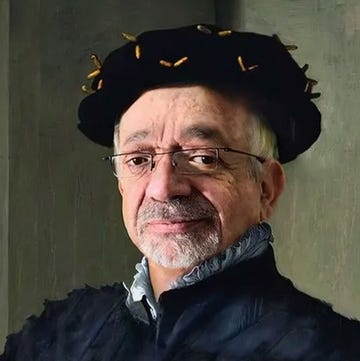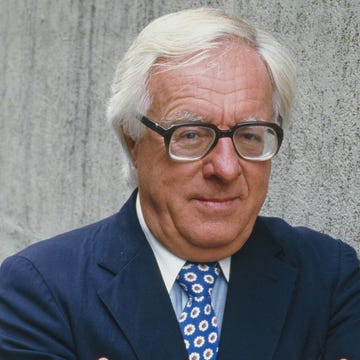My long day’s journey into the light of Ross Macdonald’s California began on a rain-soaked afternoon at Moe’s Books in Berkeley, where a first edition of The Moving Target (1949) caught my eye. I knew it had been the basis for Harper, a 1966 Paul Newman movie I loved. That was all I knew, and I was somewhat shocked when the book’s protagonist turned out to be Lew Archer, rather than the Lew Harper I knew from the film. That was hardly my only surprise: The book’s cover was faded, but the words inside burned with an intensity that captured both the harsh sunlight and the deep shadows of the Golden State. In that moment, I began to understand how Macdonald had mapped not just California’s physical geography and sources of illumination but its spiritual topography as well.
I’ve now spent the past two years reading and rereading all 18 of Macdonald’s Lew Archer novels, while driving around the state. What emerges from the work is not just a detective’s case files but a poet’s or a painter’s field notes on California’s changing landscape, real and metaphorical. And as in most poems and paintings, there’s a lot going on beneath the surface. Captain Ahab’s admonition in Moby-Dick couldn’t be more apt than when applied to Macdonald’s writing: “Hark ye yet again, — the little lower layer.”
The lower layer of California that emerges through Macdonald’s preternatural prose is a study in contrasts, where natural beauty and human corruption dance an eternal pas de deux. In The Underground Man (1971), widely considered Macdonald’s best book, Archer observes the Santa Barbara foothills, in what he calls Santa Teresa: “Before we reached Santa Teresa I could smell smoke. Then I could see it dragging like a veil across the face of the mountain behind the city.” That veil is partly conjured by what Archer is discovering as he searches for a missing boy: wayward parents, wounded progeny, and, of course, murder. In apposition with this is a canyon fire raging through the entire narrative, a sort of surrealistic nightmare: Flames are “artillery flashes,” automobiles move “like a funeral cortege,” and avocados “[hang] down from their branches like green hand grenades.”
This interplay of beauty and menace becomes a motif throughout Macdonald’s work, which suggests that in California, paradise and perdition are eternal bedfellows. In Find a Victim (1954), he notes, “The sky turned lime-white all along its edges, then flared in jukebox colors. The sun appeared in my rear-view mirror like a sudden bright coin ejected from a machine. The chameleon desert mocked the sky, and the joshua trees leaned crazily into the rushing dawn.” As with the landscape, things are not what they seem: Characters turn out to have bogus identities, a truck driver who appears to have been in an accident has really been shot, local politicians in a seemingly model community are involved with an illegal gambling operation. It all showcases Macdonald’s talent for creating morally ambiguous characters and exploring the dark underbelly of postwar American society, particularly in California’s rapidly changing communities.
Visiting Santa Barbara long after Macdonald was living and writing there makes it obvious how precisely he captured the quality of the local light. He lived in several different homes in the city, died there too. I remember William Goldman telling me in an unrelated interview that, at the end, Macdonald was still trying to write even though his Alzheimer’s was so severe he couldn’t remember the previous sentence he had typed. In Black Money (1966), Archer describes an evening in which “the sunset at the window competed in brilliance with the Van Goghs and the Gaugins. The sun burned like a fire ship on the water, sinking slowly till only a red smoke was left trailing up the sky. A fishing boat was headed into the harbor, black and small against the enormous west. Above its glittering wake a few gulls whirled like sparks which had gone out.” Anyone who has experienced a California sunset will recognize this moment, when the light seems to pause, suspended between day and night, creating what photographers and cinematographers call the magic hour. As usual with Macdonald, things are not as beautiful as they seem: Archer is hired to investigate a mysterious Frenchman who elopes with Archer’s client’s wealthy former love interest. The case quickly unravels to reveal a complex past involving gambling debts, a possible murder disguised as a suicide, and the intertwined lives of wealthy families in the affluent Southern California town of Montevista. Archer’s investigation exposes deep-rooted moral corruption and deception beneath the town’s sunny exterior, connecting present-day events to misdeeds from the past. The novel demonstrates Macdonald’s mastery of psychological depth and his ability to create a mystery that functions both as a detective story and as a profound examination of how the past haunts the present, how physical descriptions are really metaphors for emotional realities.
If there’s an acknowledged king of the hard-boiled genre, it’s almost certainly Macdonald’s better-known predecessor Raymond Chandler, who crafted ornate, metaphor-rich prose and created Philip Marlowe, a knight-errant detective in a corrupt Los Angeles. Chandler’s style also emphasizes moral ambiguity, with elaborate similes becoming his trademark, none better than “a blonde to make a bishop kick a hole in a stained-glass window” (Farewell My Lovely, 1940). But no one else in the genre—not Hammett, not Cain, not capital-D MacDonald, and not the delightful Leonard—ever begins to approach Macdonald’s extraordinary rendering of geography and light, the primordial stuff that makes California so unique. These other authors created rock-solid detective fiction, but only Macdonald elevated the material to literature.
As much as he understands human conflict, Macdonald is no less attuned to the state’s environmental challenges. His metaphors often draw on both natural and man-made elements, suggesting the uneasy relationship between California’s landscape and its human inhabitants. In Black Money, Macdonald describes the artificiality of Southern California’s newly developed communities: “Montevista is a residential community adjacent to and symbiotic with the harbor city of Pacific Point. It has only one small shopping center, which calls itself the Village Square. Among its mock-rustic shops the Montevistans play at being simple villagers the way the courtiers of Versailles pretended to be peasants.” The novel depicts the transformation of California’s natural landscape through unchecked development and exploitation. Macdonald contrasts the region’s original beauty with its degradation through commercial and residential expansion. The corruption of the land parallels the moral corruption of the characters, creating a symbolic connection between environmental and human decay.
In The Instant Enemy (1968), Archer drives through a suburban development: “It was a fairly good street, with new ranch houses sitting on pads cut one above another in the hillside. Each house was carefully different. The one across the street from me, for example, the one with the closed drapes, had a ten-foot slab of volcanic rock set into the front.” Macdonald captures both the physical reality of California’s suburban sprawl and its psychological costs. The novel depicts how rapid suburban expansion destroys both natural environments and human connections to place. Characters exist in a kind of geographic limbo: neither urban nor rural but caught in anonymous tract-housing developments and strip malls that offer no sense of community or belonging. This physical rootlessness translates into psychological instability, where people lack the grounding that comes from genuine bonds with place and neighbors. Just like Hollywood.
“Hollywood started as a meaningless dream, invented for money,” Macdonald writes in The Barbarous Coast (1956). Note that Macdonald hardly lost sight of the money. He—more likely his agent—explained to Warner Bros. that, because there were a dozen novels featuring Lew Archer (ultimately, there would be 18), the studio had to buy all 12 to use the name. Warner Bros. changed it to Lew Harper, the cause of my initial confusion about the screen adaptation of The Moving Target.
In mapping California’s physical and psychological geography, Ross Macdonald created something rare in crime fiction: a body of work that transcends genre to become genuine literature of place. His California remains as vital and complex as the real landscape that inspired it, a place where beauty and darkness coexist, where the past is never fully buried, and where the quality of light can reveal or obscure the deepest truths. •
Tom Zito is a serial entrepreneur. He came to California to report a piece on startups for the New Yorker, but launched a company instead. In addition to the New Yorker, he has written for the Washington Post, Esquire, Rolling Stone, Playboy, Cosmopolitan, Life, Newsweek, and many other publications, and has started eight companies.














